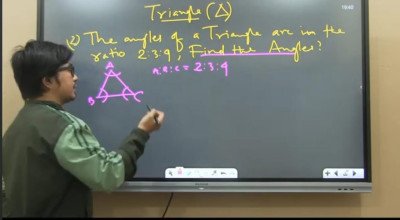Course description
In a class 11 calculus course, the study of limits and derivatives lays the groundwork for understanding the fundamental principles of calculus. Here's a brief overview of what you might expect to learn:
1. Introduction to Limits:
Definition of a limit and its intuitive interpretation.
Evaluating limits of functions algebraically, graphically, and numerically.
Understanding one-sided limits and limits at infinity.
2. Techniques for Finding Limits:
Simplification, factoring, and rationalization techniques for evaluating limits.
Using special limits such as trigonometric limits and limits involving exponential and logarithmic functions.
3. Continuity:
Definition of continuity of a function at a point and over an interval.
Identifying discontinuities and removable/discontinuities.
4. Introduction to Derivatives:
Definition of a derivative as the instantaneous rate of change of a function.
Understanding the geometric interpretation of derivatives as slopes of tangent lines.
Differentiability and its relationship with continuity.
5. Derivative Rules:
Basic differentiation rules including the power rule, constant rule, sum/difference rule, product rule, and quotient rule.
Applying derivative rules to find derivatives of algebraic, trigonometric, exponential, and logarithmic functions.
6. Derivatives of Transcendental Functions:
Derivatives of trigonometric functions, inverse trigonometric functions, exponential functions, and logarithmic functions.
Derivatives of composite functions and implicit differentiation.
7. Applications of Derivatives:
Understanding the applications of derivatives in calculus, physics, engineering, economics, and other fields.
Using derivatives to analyze rates of change, find maximum and minimum values, and solve optimization problems.
8. Related Rates:
Solving related rates problems involving rates of change of variables that are related by a given equation.
9. Curve Sketching:
Understanding how to sketch the graph of a function using information from its derivative, including critical points, intervals of increase/decrease, concavity, and points of inflection.
ক্লাস 11 ক্যালকুলাস কোর্সে, সীমা এবং ডেরিভেটিভের অধ্যয়ন ক্যালকুলাসের মৌলিক নীতিগুলি বোঝার ভিত্তি তৈরি করে। এখানে আপনি কি শিখতে আশা করতে পারেন তার একটি সংক্ষিপ্ত বিবরণ:
1. সীমার ভূমিকা:
একটি সীমার সংজ্ঞা এবং এর স্বজ্ঞাত ব্যাখ্যা।
বীজগণিতীয়ভাবে, গ্রাফিকভাবে এবং সংখ্যাগতভাবে ফাংশনের সীমা মূল্যায়ন করা।
অনন্তে একতরফা সীমা এবং সীমা বোঝা।
2. সীমা খোঁজার কৌশল:
সীমা মূল্যায়নের জন্য সরলীকরণ, ফ্যাক্টরিং এবং যৌক্তিককরণ কৌশল।
ত্রিকোণমিতিক সীমা এবং সূচকীয় এবং লগারিদমিক ফাংশন জড়িত সীমার মতো বিশেষ সীমা ব্যবহার করা।
3. ধারাবাহিকতা:
একটি বিন্দুতে এবং একটি ব্যবধানে একটি ফাংশনের ধারাবাহিকতার সংজ্ঞা।
বিচ্ছিন্নতা এবং অপসারণযোগ্য/বিরতি সনাক্তকরণ।
4. ডেরিভেটিভের ভূমিকা:
একটি ফাংশনের পরিবর্তনের তাত্ক্ষণিক হার হিসাবে একটি ডেরিভেটিভের সংজ্ঞা।
স্পর্শক রেখার ঢাল হিসাবে ডেরিভেটিভের জ্যামিতিক ব্যাখ্যা বোঝা।
ভিন্নতা এবং ধারাবাহিকতার সাথে এর সম্পর্ক।
5. ডেরিভেটিভ নিয়ম:
পাওয়ার নিয়ম, ধ্রুবক নিয়ম, যোগফল/পার্থক্যের নিয়ম, পণ্যের নিয়ম, এবং ভাগফল নিয়ম সহ মৌলিক পার্থক্য নিয়ম।
বীজগণিত, ত্রিকোণমিতিক, সূচকীয়, এবং লগারিদমিক ফাংশনগুলির ডেরিভেটিভগুলি খুঁজে বের করতে ডেরিভেটিভ নিয়ম প্রয়োগ করা।
6. ট্রান্সকেন্ডেন্টাল ফাংশনের ডেরিভেটিভস:
ত্রিকোণমিতিক ফাংশন, বিপরীত ত্রিকোণমিতিক ফাংশন, সূচকীয় ফাংশন এবং লগারিদমিক ফাংশনের ডেরিভেটিভস।
যৌগিক ফাংশন এবং অন্তর্নিহিত পার্থক্যের ডেরিভেটিভস।
7. ডেরিভেটিভের অ্যাপ্লিকেশন:
ক্যালকুলাস, পদার্থবিদ্যা, প্রকৌশল, অর্থনীতি এবং অন্যান্য ক্ষেত্রে ডেরিভেটিভের প্রয়োগ বোঝা।
পরিবর্তনের হার বিশ্লেষণ করতে, সর্বাধিক এবং সর্বনিম্ন মানগুলি সন্ধান করতে এবং অপ্টিমাইজেশন সমস্যাগুলি সমাধান করতে ডেরিভেটিভ ব্যবহার করে।
8. সম্পর্কিত হার:
একটি প্রদত্ত সমীকরণের সাথে সম্পর্কিত ভেরিয়েবলের পরিবর্তনের হার জড়িত সম্পর্কিত হারের সমস্যাগুলি সমাধান করা।
9. কার্ভ স্কেচিং:
কীভাবে একটি ফাংশনের গ্রাফ স্কেচ করতে হয় তার ডেরিভেটিভ থেকে তথ্য ব্যবহার করে বোঝা যায়, যার মধ্যে গুরুত্বপূর্ণ পয়েন্ট, বৃদ্ধি/হ্রাসের ব্যবধান, অবতলতা এবং বিন্দুর বিন্দু সহ।



















